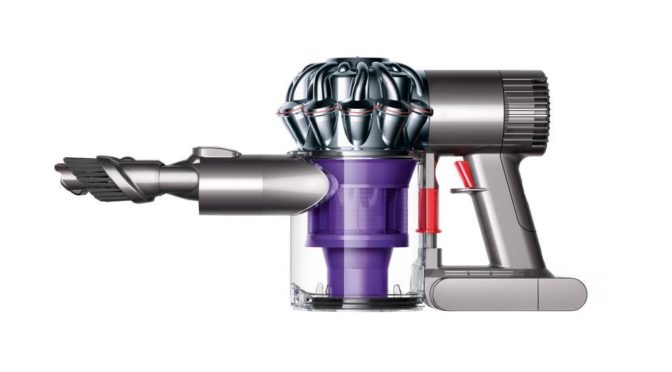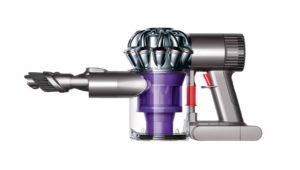
Even though we have the most experience using and reviewing upright and canister vacuums, we’re well aware that sometimes, convenience is going to come before comprehensiveness. While a robotic vacuum or handheld isn’t going to give nearly as much power on carpets, upholstery, or bare floors as a full-sized vacuum, sometimes portability trumps power. Dyson understands this more than most manufacturers, which is why their high-end line of cleaning tools has expanded from do-everything uprights like the Ball Animal 2 to portable, compact, and easily maneuverable mini vacuums like the V7 Car+Boat.
We’ve reviewed several of their cordless options lately, including the V7 Trigger. Today we’re going to look at a previous-generation model, the Dyson V6 Trigger Handheld Vacuum, and compare it to its V7 twin, the V7 Trigger. If we had to summarize our thoughts in ten seconds, we’d suggest buying the V7 Trigger for more battery life and accessories and buying the V6 Trigger if you want a slightly lighter vacuum. Our full review is below, and you can buy it here.
Pros, Cons, and Key Features of the Dyson V6 Trigger Handheld Vacuum
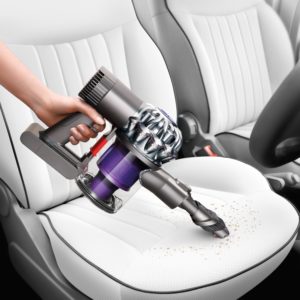
The Dyson V6 Trigger is one of far too many handheld vacuums Dyson currently has on the market; we’re not sure why there are half a dozen or more available, particularly since they mainly vary by the accessories they ship with. The V7 generation just features the Car+Boat and Trigger for now, but in the V6 generation, you can choose between the Car+Boat, Baby+Child, Top Dog, and Mattress. There are undoubtedly more forthcoming, and Dyson will surely invent more hyphenated names to distinguish them.
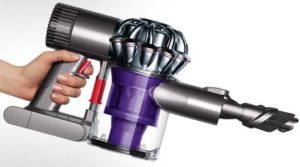
Until then, the V6 Trigger’s key features include 20 minutes of runtime, constant suction (where the battery keeps top power levels until it conks out at the last minute), two accessories (the combination tool and crevice tool), and Dyson’s impressive 2 year parts and labor warranty. The V6 Trigger weighs 3.4 pounds on our scale and is rated to deliver up to 100 airwatts of suction. Its dust bin holds .11 gallons at full capacity and you’ll need 3.5 hours to recharge its Lithium-ion battery.
When it arrives, you’ll find the V6 boxed carefully alongside a pair of tools–the aforementioned combination and crevice tools–and an AC charger.
What’s the difference between the Dyson V6 Trigger and the V7 Trigger?
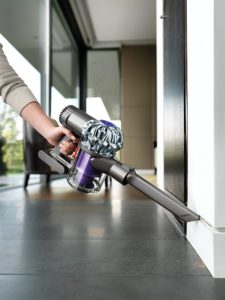
The V6 Trigger was succeeded by the V7. As a result, while both machines are designed to fulfill more or less the same roles, there are enough differences between them to make an upgrade worth considering. Alternatively, if you haven’t bought either, you might just want to skip the V6 completely and upgrade to the V7. The biggest difference has to do with battery life: you get 20 minutes of runtime with the V6 but 30 minutes, a 50% increase, with the V7 Trigger.
The difference is most noticeable when cleaning, as we frequently found ourselves in the middle of a productive session when we noticed a steep drop in power in the V6, which was a sign that the battery was a minute or two from exhaustion. The additional minutes in the V7 gave us the time to reach a good stopping point more often than not, and we realized how much we missed it when we went to clean with the V6.
Beyond the battery upgrade in the V7, it also has a larger dirt-holding capacity at .15 gallons vs a .11 gallon tank packed into the V6. Practically speaking, this is the difference between 2.4 cups in the V7 and 1.8 in the V6. While it might not sound like a lot on paper, in practice, it meant we could fit a lot more pet hair from our cats and golden retrievers in the V7 than in the V6 before we needed to dump everything out. It’s worth keeping in mind that the extra battery life and dust storage in the V7 is reflected in a slightly heavier body; the V7 weighs 3.8 pounds while the V6 clocks in at 3.4. Practically speaking, both felt almost identical in our hands, and we were more than willing to add the ounces for a boost in battery life and cleaning capacity.
The remaining significant differences between the two have to do with the accessories supplied and their connections. While the V6 ships with two capable tools–the combination tool and the crevice tool–the V7 adds a third: the mini motorized brush tool. We dearly missed this tool in the V6, as it was our favorite in the V7 Trigger due to the power it gave us when powering through stains in upholstery, carpeting, and in pretty much any kind of fabric. The V7 also adds quick release connectors to the cleaning tools, making them slightly easier to connect and disconnect from the vacuum.
It’s important to note that despite Dyson’s marketing, both vacuums appeared to have the same amount of cleaning power when using the same tools. It makes sense when you consider how both share a 100 maximum airwatt rating for suction; we’re not entirely sure why Dyson called the V7 their strongest vacuum yet besides out of a desire to convince happy V6 owners to upgrade to the V7.
How well will the Dyson V6 Trigger clean inside my car and around the house?
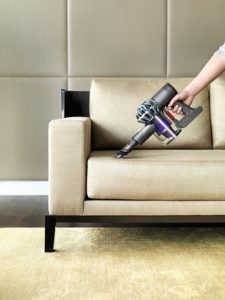
When you buy a handheld vacuum, it’s best to have reality-based expectations. It’s not going to give you the cleaning power of a full-sized upright (e.g., Dyson’s Ball Animal 2) in a 3 pound package. However, if it’s made well, it should give you a lightweight, take-anywhere, and reasonably powerful machine that can take care of dirt, crumbs, pet hair, and the myriad bits of food children leave in car seats. You should be able to clean up dirt and dust at the spur of the moment behind appliances, on your stairs and carpets, between sofa cushions and under beds, and in every nook and cranny in your minivan, SUV, or family sedan. Practically speaking, the V6 Trigger could do most of these things; it was just limited by its accessories.
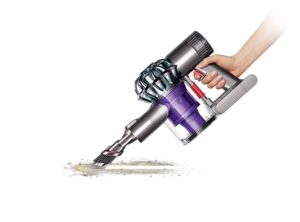
As we noted above, the V6 Trigger ships with a crevice and combination tool. We used both to the best of our abilities and got a lot of cleaning done–beside baseboards, in nooks and crannies behind fridges, stoves, and furniture–it’s a well-designed machine. However, the lack of the motorized brush found in the V7 Trigger made it difficult to work out tough stains in upholstery and on carpeting. Yes, we could get out the full-sized vacuum to take care of those, but the point of a portable vacuum is to let you clean in places and at times where you just don’t want to bring out the full-sized beast. That said, we still got things clean; it just took longer than it needed to. We also missed the extension hose present in the V7 Car+Boat greatly when it came to reaching areas that were just-an-inch-or-two away. And cars and houses have plenty of such areas.
Why buy the Dyson V6 Trigger?
Despite the somewhat miserly set of accessories it ships with, the V6 Trigger is an excellent vacuum. If we didn’t know the V7 Trigger existed, we’d be very happy with it. However, given that you can get more battery life an an extra (and very useful) accessory for about the same price in the V7 generation, we’d recommend skipping the V6 and going straight to the V7 Trigger instead. Frankly, since we felt the V7 Trigger was also somewhat understaffed, accessory-wise, we’d recommend just moving up to the V7 Car+Boat to have the full set of accessories (including the extension hose, which makes a big difference in reach) that we’d like to see in every Dyson cordless.
![]() You can buy the Dyson V6 Trigger vacuum here on Amazon. We’d recommend at a minimum upgrading to the Dyson V7 Trigger vacuum here instead. If you’d like the full set of accessories designed for the V7, you can buy the Dyson V7 Car+Boat vacuum here.
You can buy the Dyson V6 Trigger vacuum here on Amazon. We’d recommend at a minimum upgrading to the Dyson V7 Trigger vacuum here instead. If you’d like the full set of accessories designed for the V7, you can buy the Dyson V7 Car+Boat vacuum here.
![]() Canadians can buy the Dyson V6 Trigger vacuum here on Amazon. As above, we suggest buying the Dyson V7 Trigger vacuum instead or making a full upgrade to the Dyson V7 Car+Boat vacuum here for all compatible accessories.
Canadians can buy the Dyson V6 Trigger vacuum here on Amazon. As above, we suggest buying the Dyson V7 Trigger vacuum instead or making a full upgrade to the Dyson V7 Car+Boat vacuum here for all compatible accessories.
 If you find our research on PMC helpful, you can follow our efforts to keep maniacally reviewing home cleaning tools by shopping through our links above. We promise to keep fighting the good fight against every horror children, animals, and grown, yet messy humans can inflict upon a clean home.
If you find our research on PMC helpful, you can follow our efforts to keep maniacally reviewing home cleaning tools by shopping through our links above. We promise to keep fighting the good fight against every horror children, animals, and grown, yet messy humans can inflict upon a clean home.

